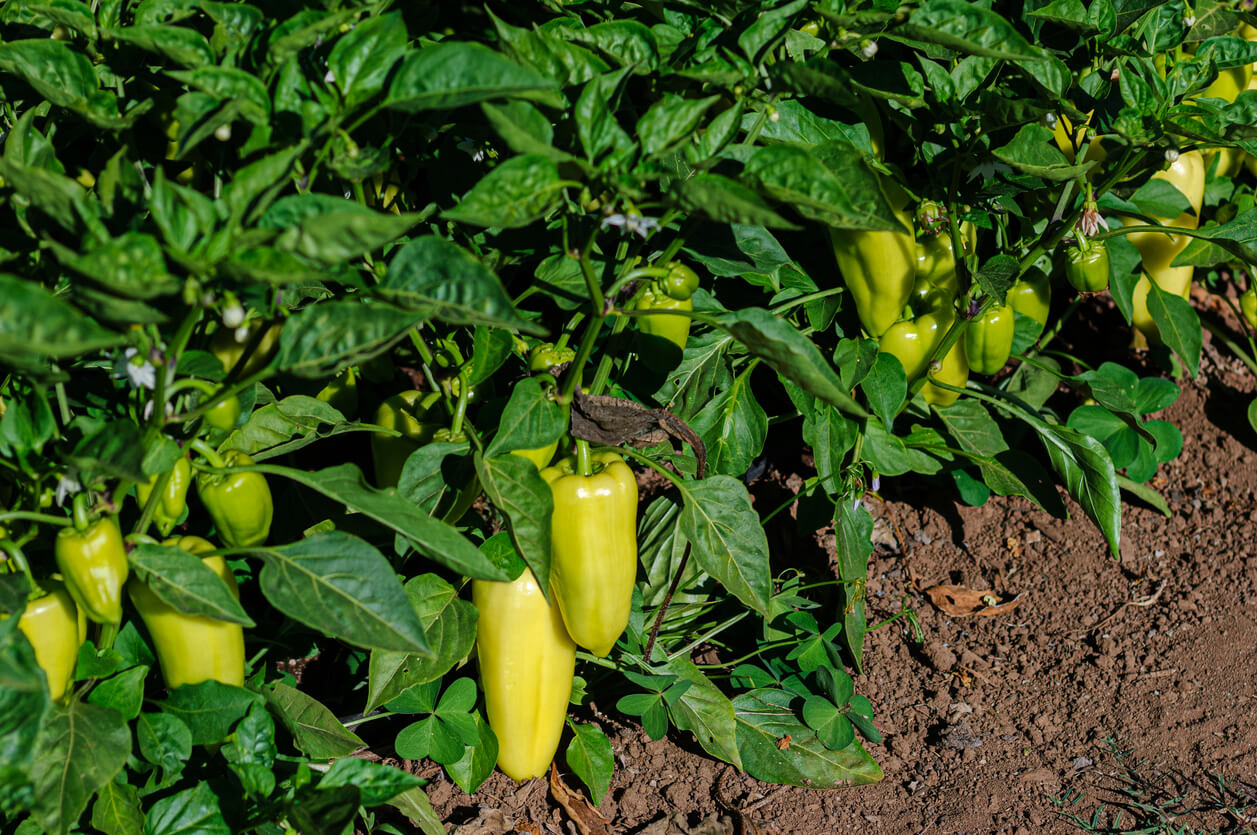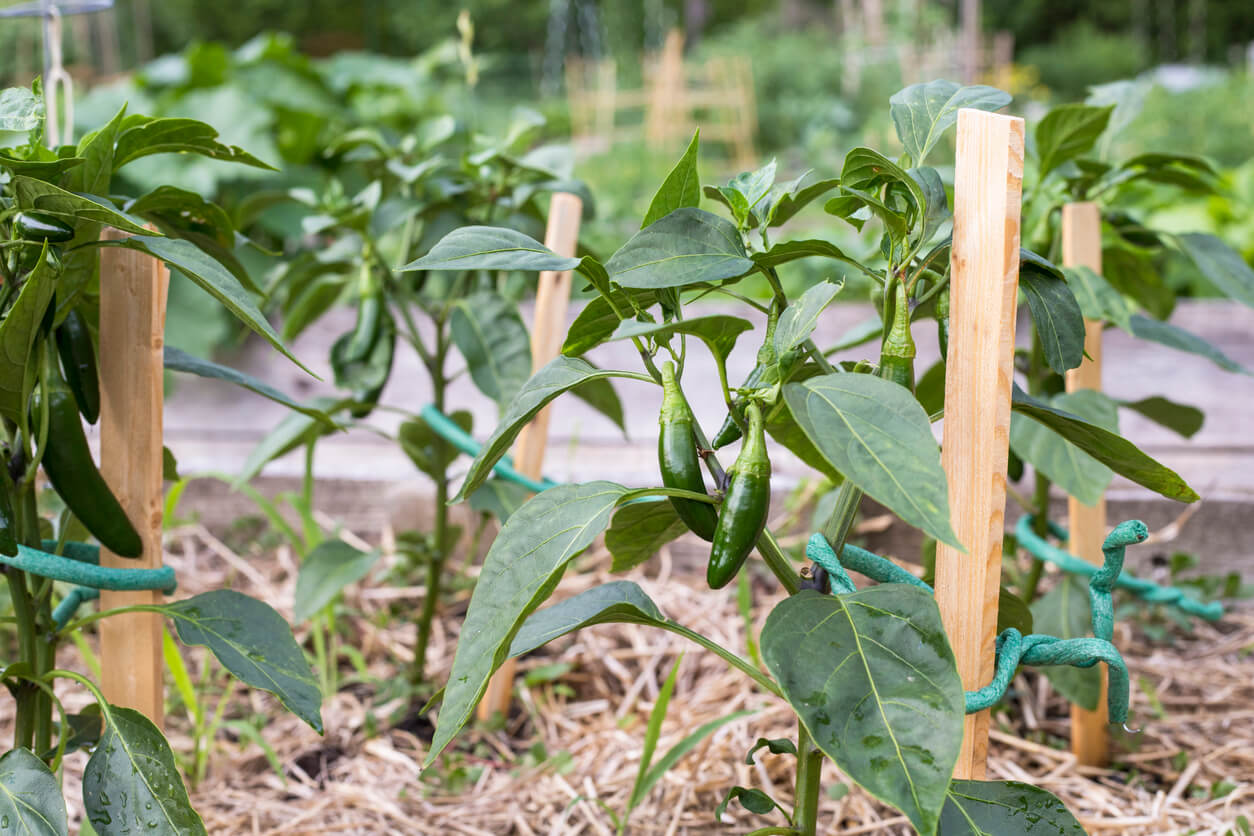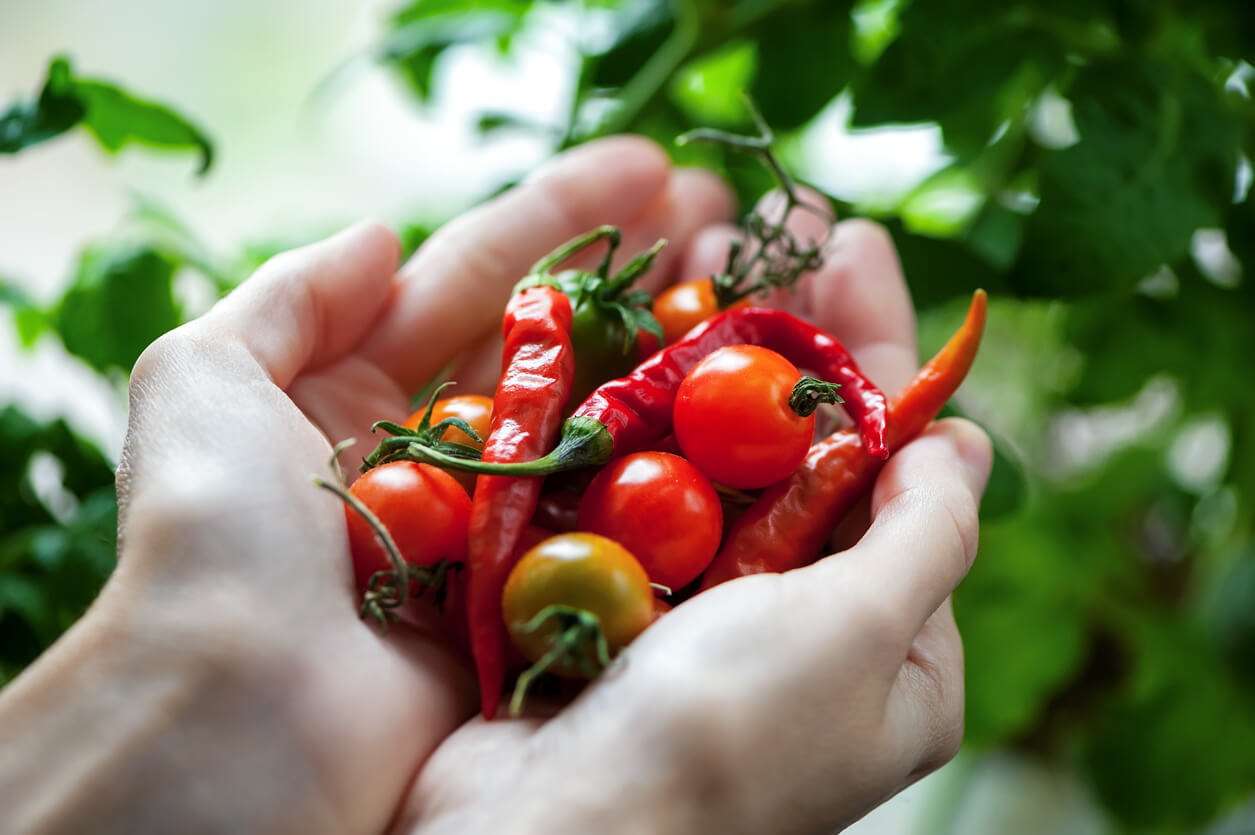
Jalapeño chile peppers growing in the garden
Planting
The easiest way to plant hot peppers is to plant seedlings. Many gardeners have success starting their hot peppers from seeds; it depends in part on your gardening setup and your level of patience. For spring plantings in temperate zones, plant your seeds once the soil temperature has reached at least 50 degrees F. Keep in mind that hot peppers do not tolerate cold, so don’t be in a rush to plant your peppers.
If you’re in a USDA Plant Hardiness Zone 8 or above, you might be able to keep your pepper plants growing through the winter—as long as the temperature doesn’t drop below 60 degrees F.
Plant Spacing
Ideally, your seedlings will be 8 to 12 inches tall by the time you’re ready to plant them. Follow the spacing instructions on your seed packet or the directions that came with your seedlings if you ordered them from a nursery. In general, hot pepper plants like some space, so plan on planting them 18 to 24 inches apart.
Your rows should be about 2 to 3 feet apart to give your plants room to grow and to give yourself some room to maneuver as you harvest. Many pepper plants benefit from a little extra support. Tomato cages make great supports; plus, you can drape a shade cloth across the top if you hit a real hot spell. Keep the ground weed-free by laying down cardboard, landscape cloth, or a thick layer of mulch.
Raised Beds

Hot peppers growing in a raised garden bed
A raised garden bed or planter is an excellent option for growing hot peppers if you don’t have soil that’s ideal for hot peppers (heavy clay soil, for example). Raised beds also help with drainage, which is essential for healthy pepper plants. You can buy raised beds or even build one yourself to fit your space. Planters should have holes in the bottom of the container and a drip tray underneath to guard against overwatering.
Watering and weeding will be easier if you have your hot peppers in a raised bed or planter. It’s a good alternative to growing in open land. And if you fill a raised bed with packaged garden soil, you know you’re providing a cleaner and healthier environment for your plants from the outset.
Packaged garden soil means less weeding than you’d have from digging a hole in the ground; and with a raised bed or container, there’s less bending down to do your weeding!
Companion Planting

Freshly harvested cherry tomatoes and chile peppers
Companion planting matches plants with soil and nutrient needs different enough that they help, rather than hinder, the growth of both plants. Good companion plants can help attract beneficial insects and deter pests, from small insects to hungry herbivorous mammals like rabbits and deer. Companion planting also helps add nutrients to the soil and reduce soil erosion. If you have limited gardening space, companion planting can help you maximize your planting area, giving you another way to squeeze in one more crop.
Here are some companion plants for hot peppers and the function they serve:
Basil. Some gardeners claim that basil makes their peppers taste better, and that it can help repel aphids, spider mites, thrips, and flies.
Beets. If you garden in a zone that doesn’t get too hot, beets are a good companion plant. And fresh beets beat canned beets, hands-down.
Carrots. Peppers have shallow roots; carrots have deep roots. Talk about maximizing space! The feathery carrot fronds can also act like a living mulch, shading out weeds.
Chamomile. Think of chamomile as a living mulch that you can eventually use to make tea.
Chard. Swiss chard can act as a windbreak and offer up a little shade for pepper plants to protect them from sunscald. Chard also does a good job of crowding out weeds, making your life a little easier.
Chives. Chives may enhance the flavor of its neighbors while also deterring aphids and other insects, which don’t like the smell of the plant.
Corn. Corn is an uncommon choice for companion planting, to be sure. But corn can offer a little shade to your pepper plants during the dog days of summer, act as a windbreak to protect your growing fruits, and work as a distraction for aphids to keep them off your pepper plants.
Dill. Dill has a reputation for attracting beneficial insects while repelling pesky ones, like aphids. It may also help improve the flavor of your pepper crop. And let’s face it, dill just looks nice in the garden.
Eggplant. Eggplant is another member of the nightshade family, just like peppers, so you never want to plant them one after the other, season to season. But planted together, they complement each other—plus you get more fresh produce from your garden. Be aware, though, that all members of the nightshade family attract similar pests. So add in some smaller companion plants as protection.
Garlic. Garlic acts as a deterrent to aphids and some beetles, protecting your peppers. It also gives you a way to sneak in another crop with minimal fuss.
Geraniums. You’re not going to eat them, but geraniums will do their part to attract pollinators and repel cabbage worms, Japanese beetles, and other pests. They also provide a great pop of color in the garden.
Leeks. Leeks have a reputation for deterring carrot flies and other pests. They don’t take up much room, and they are as delicious as their cousins garlic and onion.
Lettuce. Lettuce can help crowd out weeds and provide you with some fresh salad makings.
Marigolds. French marigolds have a longstanding reputation for repelling aphids, nematodes, slugs, and whiteflies. Word has it that they may also promote the growth of nearby crops. Plus, you can eat them!
Nasturtium. Nasturtiums have a reputation for being aphid magnets, so they can keep those pests away from your peppers. They may also repel beetles and squash bugs. If the flowers are aphid-free come pepper harvest time, you can use them as a garnish on your salad.
Okra. Okra works well as a windbreak and can offer a little shade to growing pepper plants during the hottest days of summer. It may also deter aphids.
Onions. Onions don’t take up a lot of space (compared to the sprawling pepper plants), and they may help repel aphids, slugs, and cabbage worms.
Oregano. Have a little space between your pepper plants? Plant some oregano. The two will get along in the garden—and in sauces and salads.
Parsley. Parsley offers up a little shade in the garden, and a little flavor in the kitchen.
Parsnips. This root veggie fits nicely between or among your pepper plants. You can probably come up with a good recipe to use the two together!
Petunias. Petunias repel leafhoppers, tomato worms, and aphids. And they’re beautiful.
Radishes. Radishes are super easy to grow—and they grow fast! This is your chance to sneak in an additional harvest in those in-between spaces.
Spinach. Spinach doesn’t take up much space, and it can crowd out weeds while staying out of the way of growing pepper plants. Plus, it’s delicious.
Squash. Summer and winter squash work well as hot pepper neighbors, offering up their broad leaves to shade out weeds while shading your peppers from sunscald.
Tomatoes. When it comes to crop rotation, planting tomatoes or peppers after each other is a big gardening no-no. However, you can plant them as garden bed buddies in the same season. Just be sure to rotate them out of there for the next season. Tomatoes can help shade out weeds and offer peppers a little respite from the heat of the day. One word of warning: tomatoes are susceptible to the same pests and diseases as peppers, so you want to give each plant its own space. You should also plant some low-profile plants that repel aphids and other pests that like peppers and tomatoes.
How do you plant your hot peppers? What criteria for site selection has worked for you? Do you use your hot peppers as companion plants? Please share your ideas with us.


 Previous
Previous

